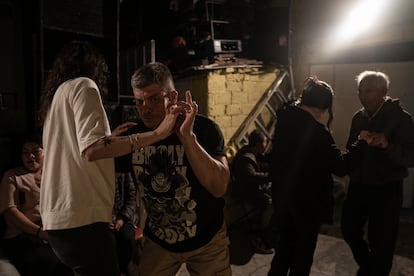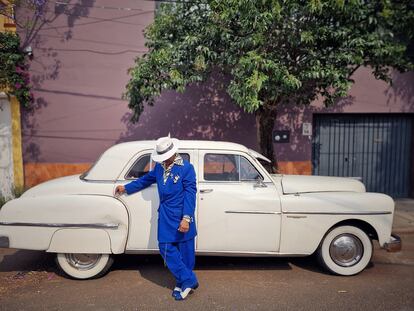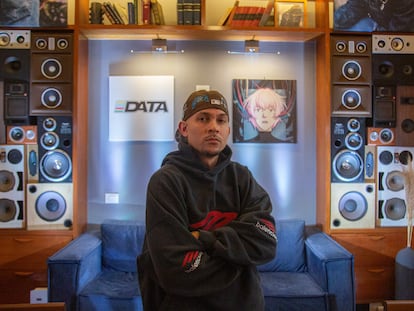From Vinyl to USB: The evolution of Mexico City’s ‘sonideros’
After being banned in some places, the Mexican capital’s government seeks to have the phenomenon of pop-up street DJs declared an intangible cultural heritage

As 30 people dance to the rhythm of a cumbia in the patio of a bookstore in the center of Mexico City, the sonidero Discos Morelos (José Ortega) studies the atmosphere. A few seconds later, he bends down and drags a box with dozens of vinyl records towards him. “I play with the music and the music plays with me,” he says. He pulls out one album, looks at it and gets ready to put it on the turntable. Next to him, Sonido Continental (Miguel Cruz), livens up the crowd. “Here’s a shout-out to Jorge and to all the people of San Luis Potosi…” This is the phenomenon of the sonideros, the pop-up street DJs that the government of Mexico City seeks to have declared as intangible cultural heritage.
Discos Morelos was born 73 years ago in the small neighborhood of Peñon de los Baños, east of the city. He claims that this was the birthplace of the phenomenon, and that he “only says what he knows.” He began working the turntables when he was 10 years old and used to help his uncle move his music equipment around the different neighborhoods, and has not stopped since: first he had a small record stand with his brother in the Tepito neighborhood, and later he began to play music in different places, in different countries. He maintains his style: “You see the people, get it? There’s a lot of very beautiful music. You have to go with the tastes of the people.”
The sonidero scene of the Mexican capital came into conflict in February, when Sandra Cuevas, the mayor of the borough of Cuauhtemoc, banned the small pop-up “dance clubs” that for years had brought together the residents of the Santa Maria la Ribera neighborhood. The politician stated that her decision had been motivated by “many noise complaints from neighbors,” and proposed that they be relocated to enclosed spaces. Meanwhile, the complaints that the Legal Department of Mexico City received for “noise” between January and December 2022 amounted to three.
One month later, Cuevas turned the situation around by recognizing the sonideros as “cultural heritage” and sharing a photo of her with 20 of their representatives holding the title. Afterwards, the secretary of culture of Mexico City, Claudia Curiel, stated that the declaration of heritage required a long process that involved authorities and specialists, and that it could only be offered by the head of government. “It’s not just handing out a diploma,” said Curiel.
A citywide phenomenon
Joyce Multicolor grew up in Iztapalapa, a neighborhood where sonideros are considered a lifelong tradition. She saw those dances that filled the streets as an escape from her responsibilities: first school, later, work. It was her only distraction, as there were no nightclubs nearby. “We didn’t have access to those things. Our only entertainment and our only identity were those weekend street parties.” She studied music analysis and Latin rhythms so she could teach audio, engineering and music analysis. Then, 14 years ago, she entered the sonidero business. Today she is 36.

Swiss photographer Mirjam Wirz has studied the phenomenon for 13 years. This investigation has led her to meet some of the city’s great sonideros, such as Discos Morelos himself. She has noticed a change since their popularity reached the center of the capital. She began to attend massive events; she liked to watch the atmosphere, how the people from the vicinity gathered, sold food, offered restroom services and more. “Everyone was part of that event, and it felt like something big [...] it is a lifestyle,” she says. She captured some of those scenes in books like Sonidero City. Wirz also toured the halls and events held by some “first generation” sonideros (those who had been involved in the phenomenon since the 1970s); smaller family events that used vinyl records instead of USB sticks.
Leaving the stigma behind
Recently, Joyce Multicolor read that the initiative for the sonideros to be declared as heritage was “under evaluation.” She did not take it well. “I was offended. It’s a process that has been going on for more than 60 years in Mexico City, and I don’t think that an investigation is necessary.” The sonidero phenomenon has come up against class stigmas, just like some genres such as rap or reggaeton. For years, it has overcome the barrier. Joyce is a living example: “In these 14 years I have worked everywhere from the most marginalized places to international festivals, and in the end it’s the same job, I never try to change it. Sonidero is sonidero, no matter where you go,” she declares.
The Swiss photographer raises several questions, such as why the idea of declaring the phenomenon as cultural heritage arose after its success reached the center; or how a title of this nature could affect the essence of the phenomenon. “The idea is a bit complicated. It’s like preserving something, but by preserving it sometimes you kill it; you don’t let it develop,” she reflects. “What they needed was some support, like permits, or some security, like the soccer matches have. It would not be unusual for aspects such as racism or classism to become involved [in this type of initiative].”

Among her many questions, Wirz wonders who is involved in this initiative. The secretary of culture, Claudia Curiel, said at the beginning of July that the department had been preparing the declaration for more than a year, and that it had met with several cultural representatives of the phenomenon. “For us [the Department of Culture] it is important that you remain united as sonideros, because this is an issue that covers the entire culture and trade, it is not just for one group,” she said.
Discos Morelos is an easygoing man, somewhat suspicious of certain topics. “It is not possible [to name sonideros a heritage]. At present you do not know who the sonideros are. How many do you think there are in Mexico [City]? Now everyone is a sonidero. They whip out their USB stick and their computer and they are sonideros. No, that’s a bad idea.” He is a purist of the phenomenon. He lists the essential equipment: speakers, a box of records, a turntable... “Who brings all that? Now they just take their computer, their USB stick, they plug in and they are sonideros... How can that be a heritage?”
In the bookstore patio, Discos Morelos looks up from the turntable again. He watches and ponders what the next song should be, the right one for the moment. He bends down briskly, looks at the cover of another of his albums, pulls out the record and sets it up. Sonido Continental cries out: “We are going to dance as much as we can!” Apparently, it worked. The music continues, and the thirty people continue dancing to the rhythm of the Colombian cumbias. Then, Discos Morelos comes out of the little makeshift corner where he set up the record player and joins the dance.
Sign up for our weekly newsletter to get more English-language news coverage from EL PAÍS USA Edition
Tu suscripción se está usando en otro dispositivo
¿Quieres añadir otro usuario a tu suscripción?
Si continúas leyendo en este dispositivo, no se podrá leer en el otro.
FlechaTu suscripción se está usando en otro dispositivo y solo puedes acceder a EL PAÍS desde un dispositivo a la vez.
Si quieres compartir tu cuenta, cambia tu suscripción a la modalidad Premium, así podrás añadir otro usuario. Cada uno accederá con su propia cuenta de email, lo que os permitirá personalizar vuestra experiencia en EL PAÍS.
¿Tienes una suscripción de empresa? Accede aquí para contratar más cuentas.
En el caso de no saber quién está usando tu cuenta, te recomendamos cambiar tu contraseña aquí.
Si decides continuar compartiendo tu cuenta, este mensaje se mostrará en tu dispositivo y en el de la otra persona que está usando tu cuenta de forma indefinida, afectando a tu experiencia de lectura. Puedes consultar aquí los términos y condiciones de la suscripción digital.
More information
Archived In
Últimas noticias
Most viewed
- Alain Aspect, Nobel laureate in physics: ‘Einstein was so smart that he would have had to recognize quantum entanglement’
- Mexico’s missing people crisis casts a shadow over World Cup venue
- Why oil has been at the center of Venezuela-US conflicts for decades
- Trump clarifies who is ultimately in charge in Venezuela: ‘Me’
- Mexico seeks to shore up its defenses following US incursion in Venezuela











































